Category Archives for Uncategorized
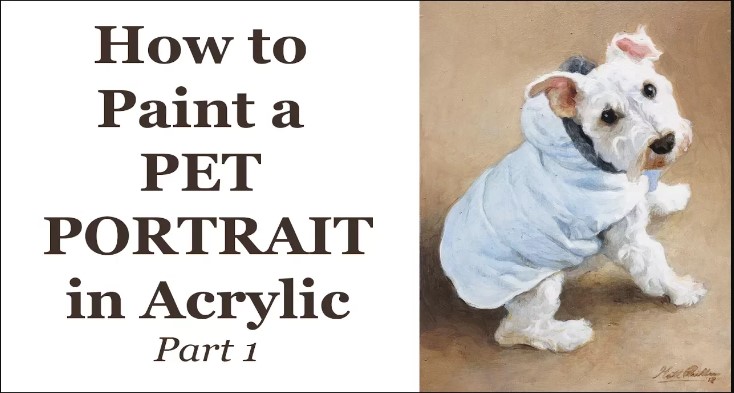
How to Paint a Pet Portrait in Acrylic
If you’re a portrait artist, it won’t be long before you’ll be asked to paint a portrait someone’s beloved pet. And you’ll want to know how to do it.
I will show you how, using the acrylic glazing technique, in this first part of a 5 x 7 acrylic on hardboard commissioned pet portrait demonstration.
How to Paint a Pet Portrait Part 2
I’ll show you how he gives his acrylic pet portrait depth as adds shading, nuances and differentiates the dog from the background by using the correct values in shadows.
- Adding highlights to your acrylic painting
- 5 Excellent Reasons to Use Aluminum Foil
- Paint Realistic Wrinkles in Acrylic
- Painting Clothing in an Acrylic Portrait
- Paint a Cloudy Sky Acrylic
- How to add Semi-Opaque Highlights
- How to Enhance the Contrast in Your Acrylic
- How to Add Glaze to Your Acrylic Painting
- Paint Realistic Reflections on Eyeglasses in an Acrylic Portrait
- Build Up Depth on Your Acrylic Portrait Backgrounds
- How Do You Do Layers With the Glazing Technique?
- Learn How to Paint Wrinkles in Acrylic
Read more about how to paint a portrait that you can surely be proud of!
I’d love to hear your thoughts on this video. Please share it with your friends and family. Let me know if you have any further questions. I’ll greatly help you.
If you’d like to learn more, sign up for my free email tips and video class today.
Learn How to Paint Acrylic Portraits With My Free Mini-Video Course!
Thank you so much for taking the time to read this tutorial and watch the video. That means a lot to me. I hope you find it very helpful in your portrait painting.
Yours for Better Portraits,
P.S. Did you find this post helpful or encouraging? If so, send it on ahead! Let others know with the share buttons below. I’d love to hear your comments. Thank you so much! Also, do you have a question on acrylic portrait painting you’d like answered? Let me know, and I’d be happy to help!
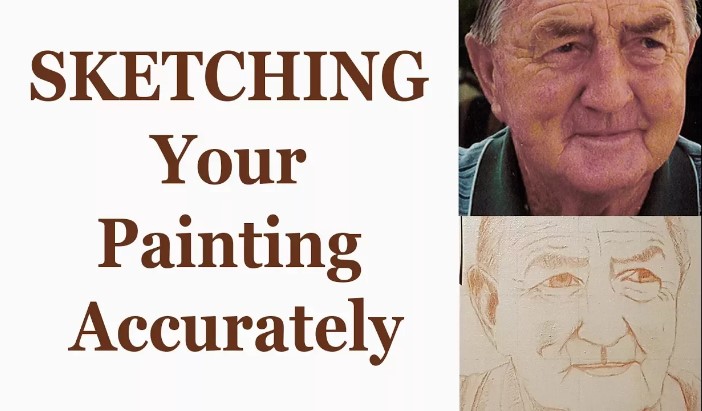
Sketching Your Painting Accurately
Every house has a foundation. A painting is no different.
I’ll show you how I helps a student in the sketching process in this critique to make sure the painting starts out well!
Watch my tutorial to learn more about sketching your painting accurately.
- Adding highlights to your acrylic painting
- 5 Excellent Reasons to Use Aluminum Foil
- Paint Realistic Wrinkles in Acrylic
- Painting Clothing in an Acrylic Portrait
- Paint a Cloudy Sky Acrylic
- How to add Semi-Opaque Highlights
- How to Enhance the Contrast in Your Acrylic
- How to Add Glaze to Your Acrylic Painting
- Paint Realistic Reflections on Eyeglasses in an Acrylic Portrait
- Build Up Depth on Your Acrylic Portrait Backgrounds
- How Do You Do Layers With the Glazing Technique?
- Learn How to Paint Wrinkles in Acrylic
Read more about how to paint a portrait that you can surely be proud of!
I’d love to hear your thoughts on this video. Please share it with your friends and family. Let me know if you have any further questions. I’ll greatly help you.
If you’d like to learn more, sign up for my free email tips and video class today.
Learn How to Paint Acrylic Portraits With My Free Mini-Video Course!
Thank you so much for taking the time to read this tutorial and watch the video. That means a lot to me. I hope you find it very helpful in your portrait painting.
Yours for Better Portraits,

P.S. Did you find this post helpful or encouraging? If so, send it on ahead! Let others know with the share buttons below. I’d love to hear your comments. Thank you so much! Also, do you have a question on acrylic portrait painting you’d like answered? Let me know, and I’d be happy to help!
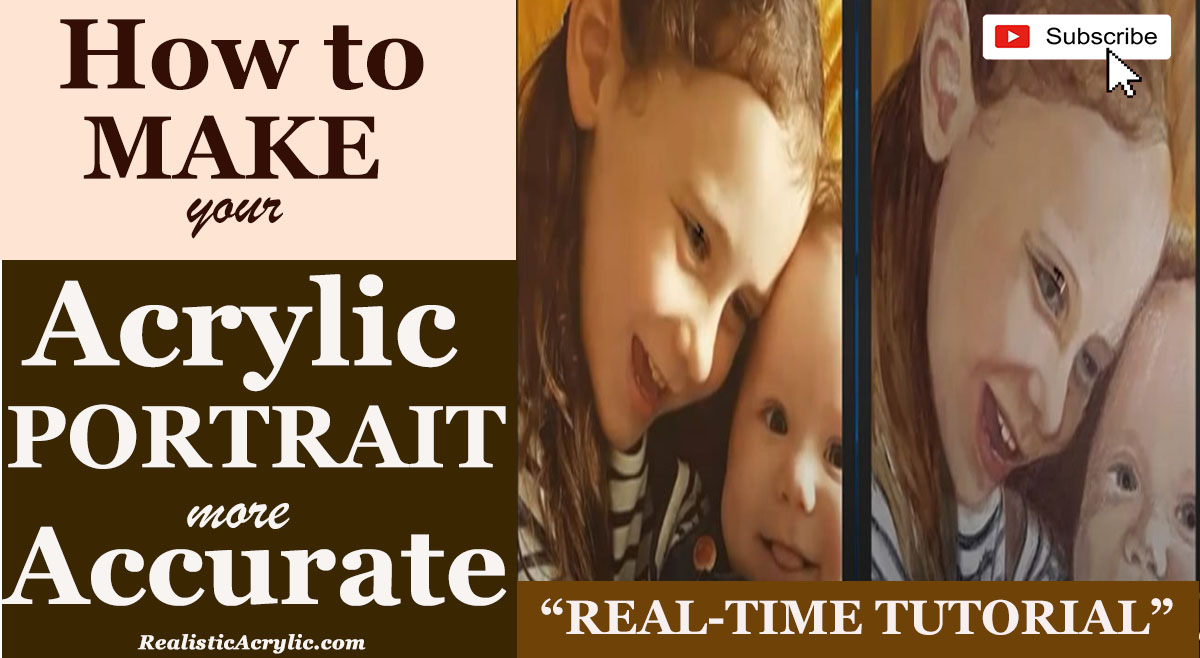
How to Make Your Acrylic Portrait More Accurate
Do you struggle to get accurate features in your portrait?
In this interactive video critique, I’ll show you how to make corrections to the facial features, such as the eyes, and mouth. A few changes can create a better likeness of the subject. It can make a good portrait, great.
Watch the free video tutorial below to learn more about how to make your portrait more accurate and how to make your portrait excellent!
How to Make Your Portrait More Accurate
LEARN MORE
-
Adding highlights to your acrylic painting
-
5 Excellent Reasons to Use Aluminum Foil
-
How Photoshop alter your Photo
-
Painting Clothing in an Acrylic Portrait
-
Paint a Cloudy Sky Acrylic
-
How to add Semi-Opaque Highlights
-
How to Enhance the Contrast in Your Acrylic
-
How to Add Glaze to Your Acrylic Painting
- How to Paint Realistic Reflections on Eyes in Your Acrylic Portrait
Read more about how to paint a portrait that you can surely be proud of!
I’d love to hear your thoughts on this video. Please share it with your friends and family. Let me know if you have any further questions. I’ll greatly help you
If you’d like to learn more, sign up for my free email tips and video class today.
Learn How to Paint Acrylic Portraits With My Free Mini-Video Course!
Thank you so much for taking the time to read this tutorial and watch the video. That means a lot to me. I hope you find it very helpful in your portrait painting.
Yours for Better Portraits,

P.S. Did you find this post helpful or encouraging? If so, send it on ahead! Let others know with the share buttons below. I’d love to hear your comments. Thank you so much! Also, do you have a question on acrylic portrait painting you’d like answered? Let me know, and I’d be happy to help!
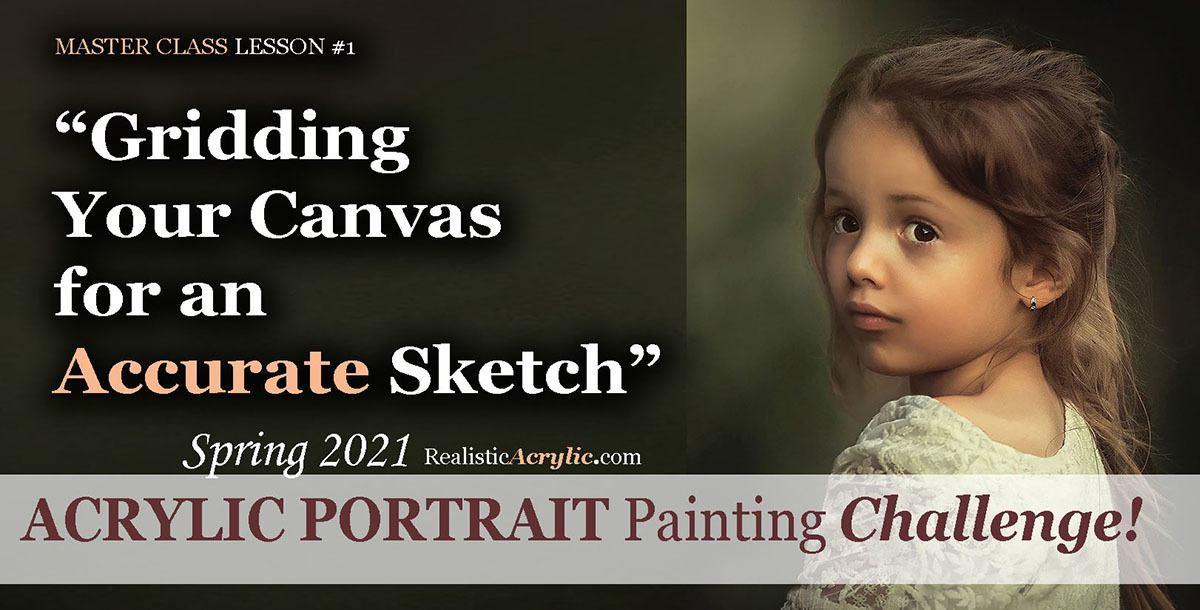
Spring 2021 Acrylic Portrait Painting Challenge: Gridding Your Canvas for an Accurate Sketch
One of the biggest struggles portrait artists have is getting an accurate likeness. In this lesson, I will show you how to grid your canvas, so that you will be able to not only make a sketch with good proportions but also get a good likeness too.
I’ll show you exactly how to do it in this video…
Gridding Your Portrait for an Accurate Sketch
Would like to paint this portrait with me and hundreds of other artists?
Take the 2021 Spring Portrait Painting Challenge!
You can register below and get started. It is completely FREE to join the challenge and participate. When you join, I’ll send you the “Welcome Kit” which includes:
- The Supplies List (so you know what you need to paint with us, your shopping list. 🙂 )
- The Reference Photo with and without the grid, high resolution, that you can download ready to print out or display on your tablet. You’ll be able to create an accurate portrait this way.
- The Palette Layout Guide showing you how to arrange your colors so they don’t get muddy on your palette
- The Master Class Lesson Schedule
- the Lessons emailed to you
- A private Facebook group to cheer you and help answer your questions
- And a few “bonuses” like opportunities to win my paid online classes
REGISTER TODAY. The challenge is ongoing, something you can do at your own pace. It’s not too late to enter!
Register for the Challenge!Let me know if you have any questions and I look forward to teaching you more!
—Matt
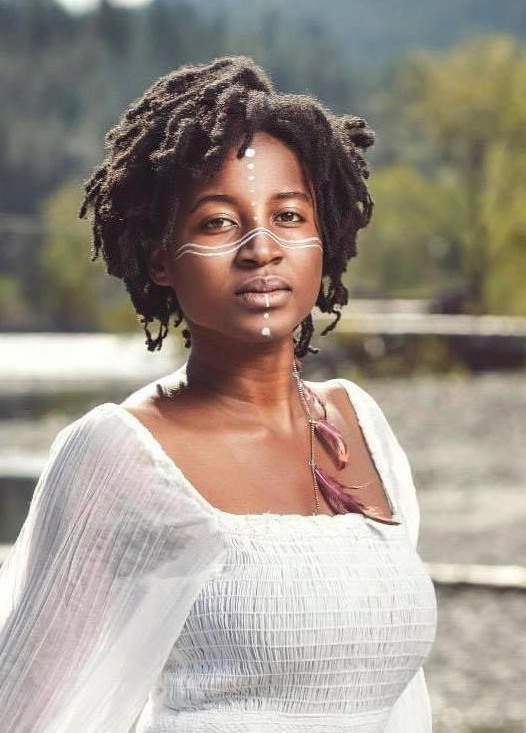
Take the Fall Acrylic Portrait Painting Challenge!
Have you ever wondered if you could paint a portrait?
You can.
Take the Fall Acrylic Portrait Painting Challenge.
Last Spring, over 700 artists took the challenge and many painted an amazing portrait, their very first time. This jump-started some of the artists into doing commissioned portraits or painting beautiful pictures of their children and grandchildren.
In the challenge, we’ll all paint the same image together and I’ll teach you how to do it, step-by-step with demonstration videos.

Reference image for the Fall Acrylic Portrait Painting Challenge. Photograph by Jonah Greenman, used with permission
The Acrylic Portrait Painting Challenge is free to join and participate.
Register below to get the Welcome Kit, which includes the Supplies List, the Full Resolution Reference Image with a Grid, Palette Layout Guide, and the Masterclass Video Lesson Schedule.
Register for the Challenge
I look forward to seeing you paint a portrait you can be proud of!
And now, here are the Masterclass Lessons:
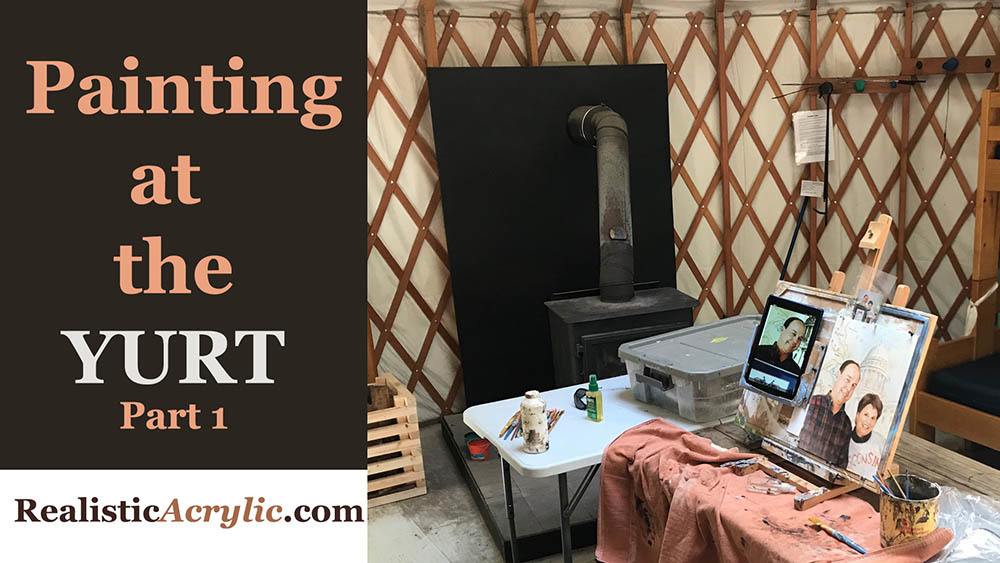
Portrait Painting of a Veteran at the Yurt
Is it possible to do portrait painting while you’re away from your home, your usual studio area?
This was something I’ve always wanted to do: create art while camping. And for all the years I’ve gone camping, I’ve never been able to successfully do it.
But finally, at the end of June, my brother and I decided to go camping at a rustic yurt up in Cable, WI. Where is that? Let’s just say, it’s “way up north.” 🙂 And what is a yurt? It’s a round tent-like house, a permanent structure made of lattice wood, bound together with steel cable, and covered with fabric. We rented it through Airbnb for two days.
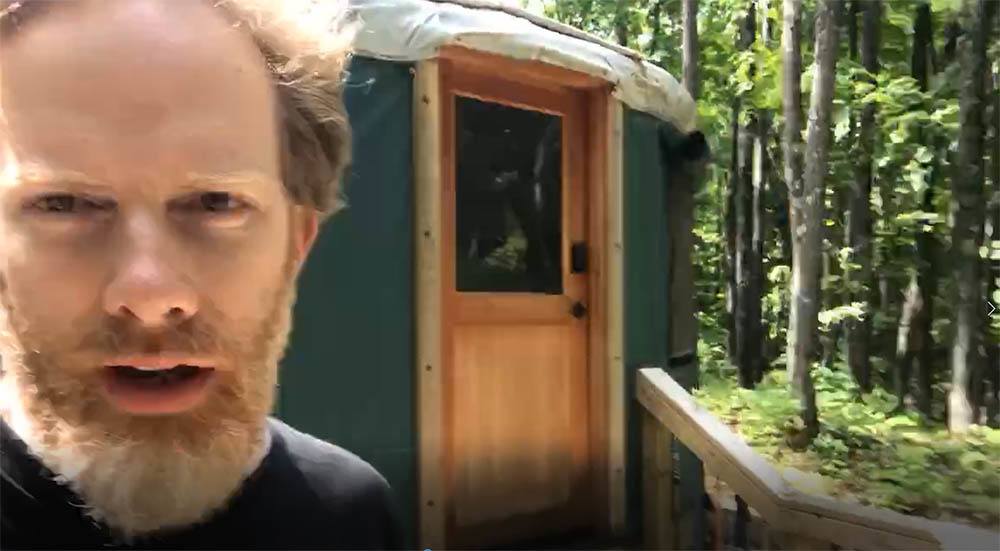
Acrylic portrait artist Matt Philleo ready to paint at a yurt in Cable, Wisconsin
We parked at the bottom of the hill and carried our gear up about a mile. We realized how out of shape we were! I also had my painting supplies: easel, palette, and brushes with me. In the middle of hiking and cooking, we decided to both do a little work: my brother wrote (he’s an author) and I painted.
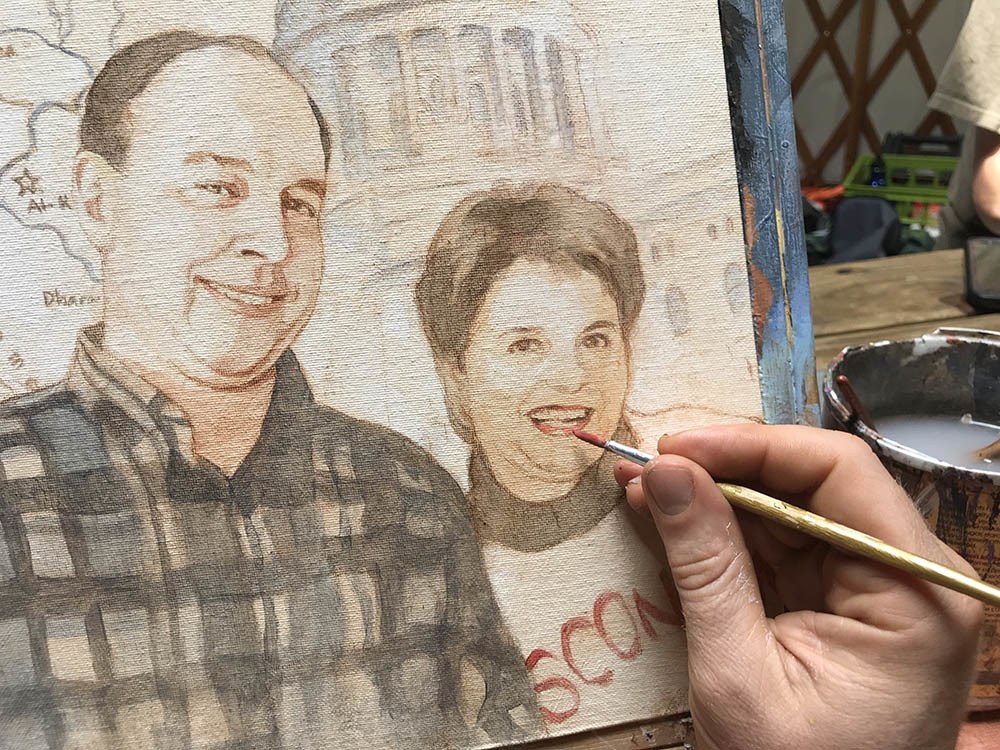
Painting an acrylic portrait from photo inside a yurt while camping, 11 x 14 acrylic on canvas ©2019 by Eau Claire area portrait artist Matt Philleo
I know. You’re probably thinking I should have painted the scenery up there, and yes, it was beautiful. But I had a commissioned portrait from a photo to get done: a painting of a veteran that served in the gulf war. And I love painting people, so it hardly seemed like work.
After bacon, eggs, and oatmeal for breakfast, it was time for painting.
Here is a video showing the beginning part of the process. In this video, I am basically blocking in the values with just raw umber dark and ultramarine blue. Of course, it’s all thinned out and made translucent with matte medium.
And then, here’s the next video in the process. Here I’m adding some color with burnt sienna, alizarine crimson and a few other colors. We’re starting to build up some skin tones. Also working on the flannel shirt. It takes a lot of layers to get it dark enough to look realistic!
After lunch, we hiked, and then came back and did more work: refining the shadows and making sure the likeness is accurate.
Sometimes your sketch just won’t cut it. It will get you about 80% of the way there, and you do the remaining 20% with paint. As you apply the paint, you can change the shape of the nose, the distance between the eyelids, lengthen the smile, etc., to adjust whatever might have been off during your sketch.
Of course, there is more to go on the painting. I’ll share the rest with you soon. I wasn’t able to finish it at the yurt, but I put in several hours. So, not only did I get to spend some great quality time with my brother, but I got to do some enjoyable work as well. After the big move, I finally feel like I’m getting into a regular groove of painting and posting tutorials. Thanks so much for your patience.
UPDATE: Here is the final video of this portrait, painted at my regular studio…
And a photo of it…
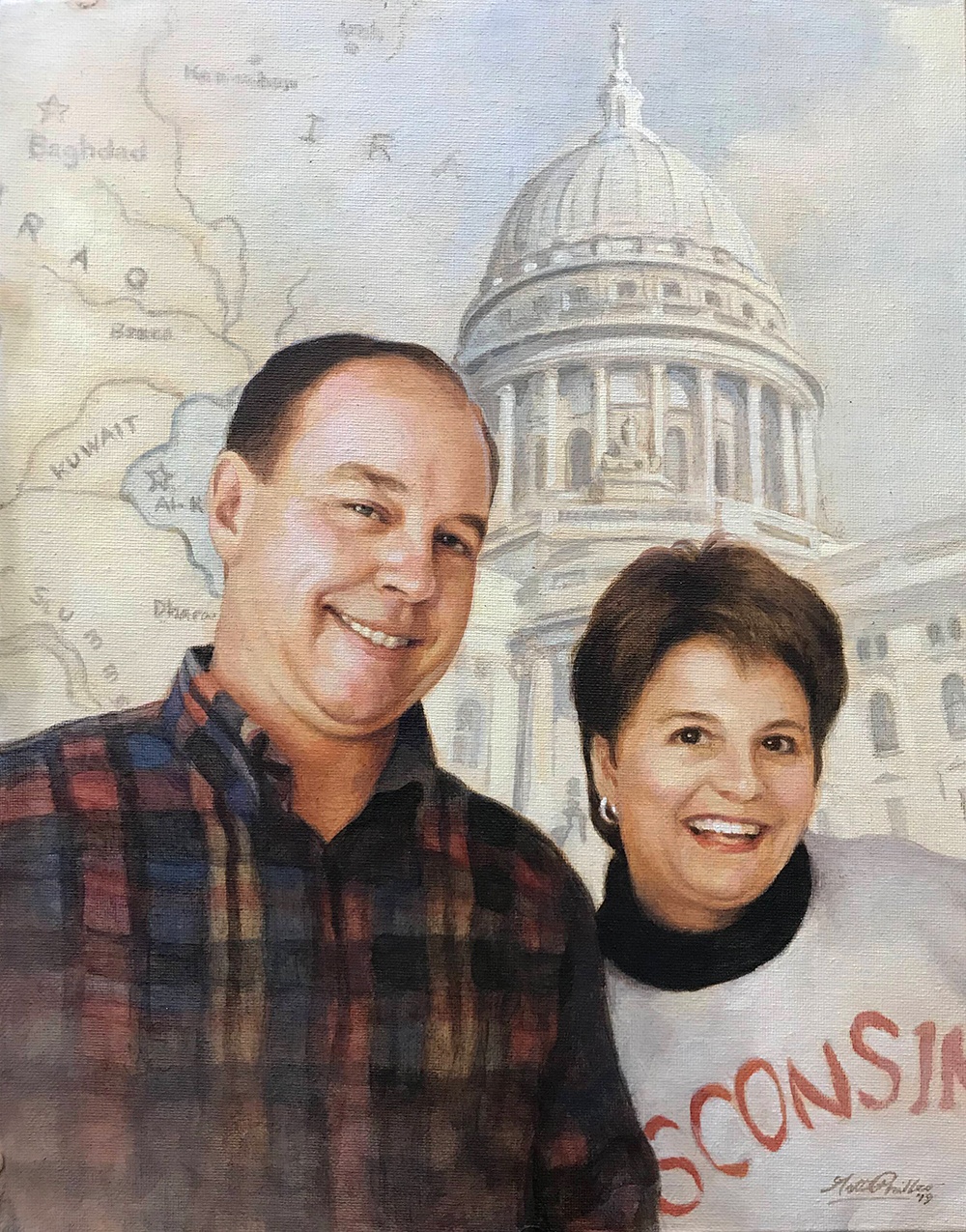
Custom realistic acrylic portrait of a veteran and his wife painted by Eau Claire area portrait artist Matt Philleo, 11 x 14, acrylic on canvas, ©2019 by Matt Philleo
I really enjoyed painting this for the client, putting all the elements–the map of Iraq, the capitol building, and the people together into one cohesive portrait that I hope will be a cherished keepsake for the family for years to come.
I hope this painting has encouraged you and given you some ideas to use in your own portrait painting. I would love to help you learn to paint portraits your very best. Let me know if I can be of more help to you in any way.
Yours for better portraits,

P.S. Did you find this post helpful or encouraging? If so, send it on ahead! Let others know with the share buttons below. I’d love to hear your comments. Thank you so much! Also, do you have a question on acrylic portrait painting you’d like answered? Let me know, and I’d be happy to help!
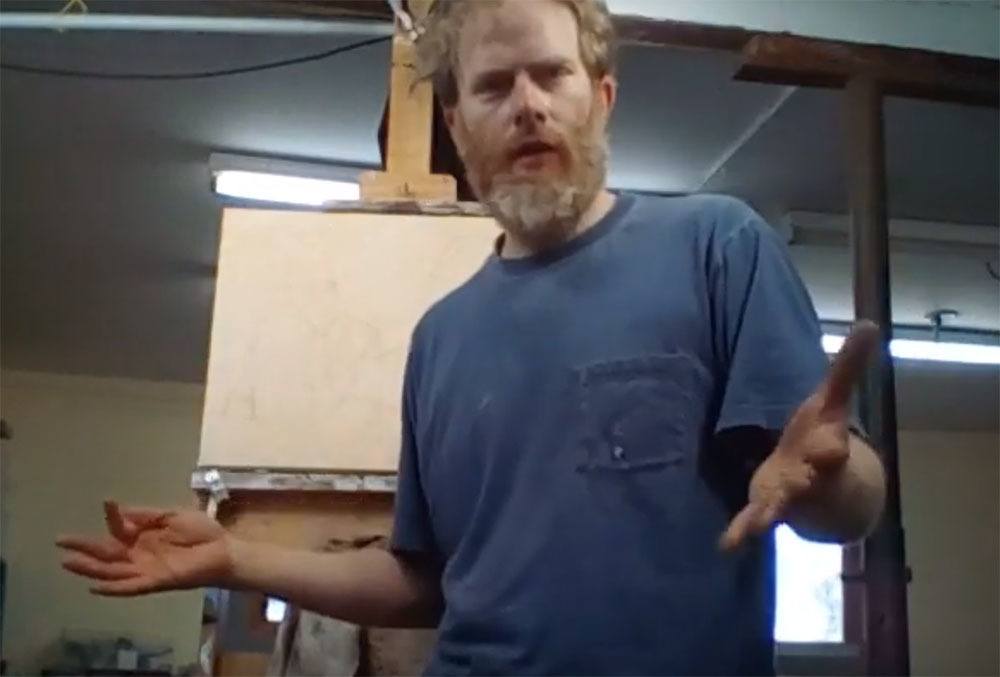
Quick Tip to Set Up a Canvas in Your Easel
Have you ever been frustrated trying to paint the edges of your canvas on an acrylic portrait, because the easel clamps are in the way?
You try to paint the background smoothly, with gestural strokes that flow off the edge of the painting but are inhibited by the easel itself. Let me show you a quick tip to overcome that problem.
How do YOU keep your paintings in place on your easel, and yet make it possible to paint all edges easily? Let me know. Always on the lookout for good ideas. 🙂

P.S. Did you find this post helpful or encouraging? If so, send it on ahead! Let others know with the share buttons below. I’d love to hear your comments. Thank you so much! Also, do you have a question on acrylic portrait painting you’d like answered? Let me know, and I’d be happy to help!
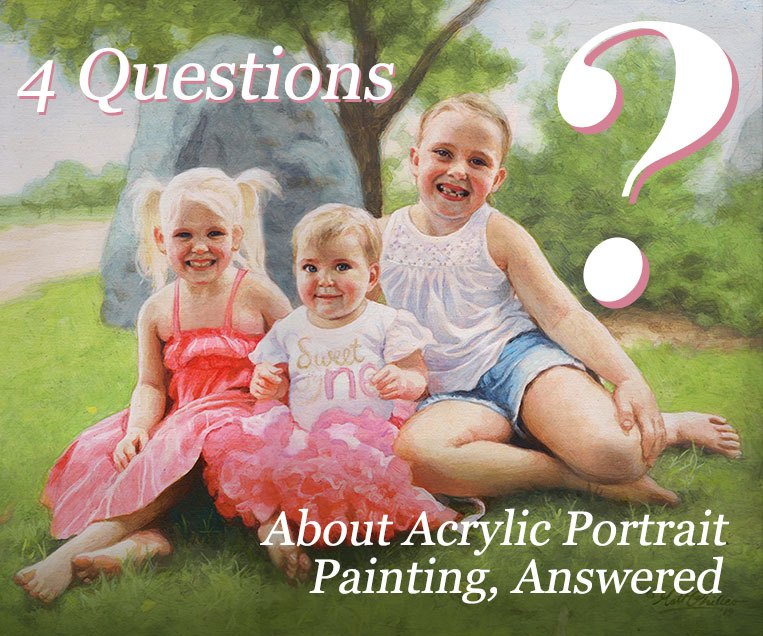
4 Questions About Acrylic Portrait Painting, Answered
Recently, I was asked some questions about acrylic portrait painting. I hope the answers I shared with this artist can be of help to you as well.
1. How do you prepare your canvas panel for painting with Acrylics?
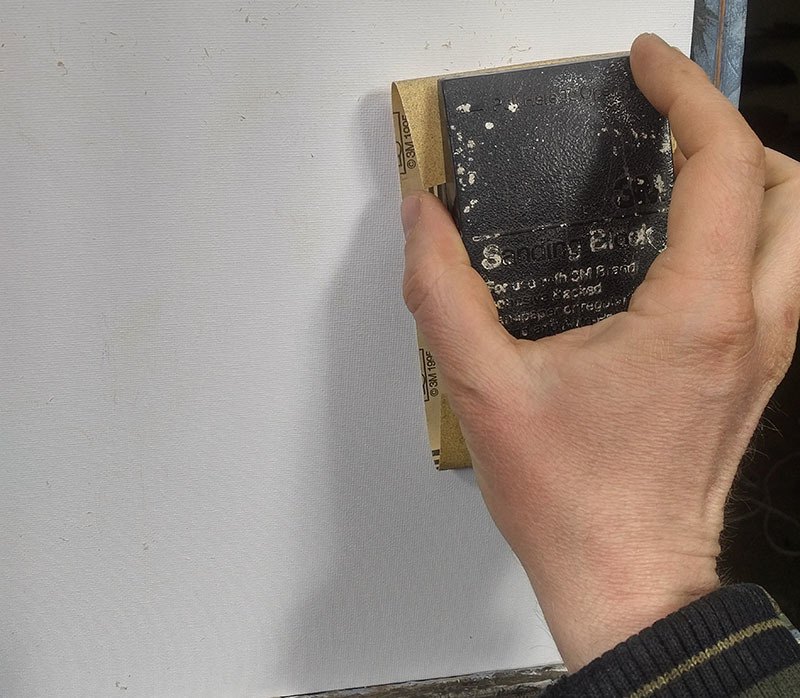
Sanding a canvas panel in preparation for painting an acrylic portrait
2. You spoke of layering your paint when composing a portrait. Please briefly explain.
I use the glazing technique to slowly bring the portrait from a white canvas to completion. The glazing technique is achieved by mixing your paint with clear acrylic medium (usually matte medium) to disperse the pigment, thus allowing light to pass through.
Although you could use water, it’s not recommended, because it breaks down the acrylic resin binder, causing a rough visual texture and possible poor adhesion. For a smoother look, you want to use clear acrylic medium.
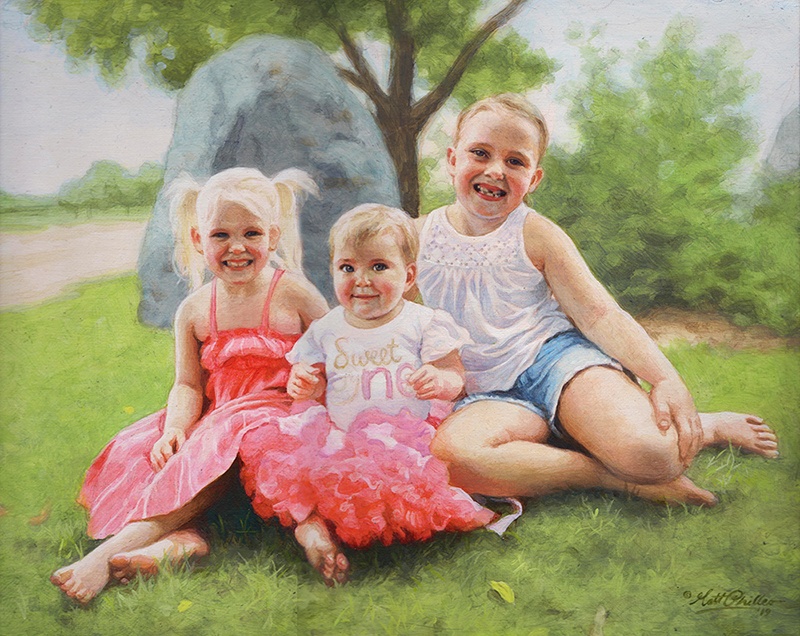
Custom commissioned realistic acrylic portrait from a photo painted by Eau Claire area artist Matt Philleo, ©2019 Fine Art by Matt Philleo
3. You mentioned using a Prismacolor pencil for making your diagram. What color do you recommend?
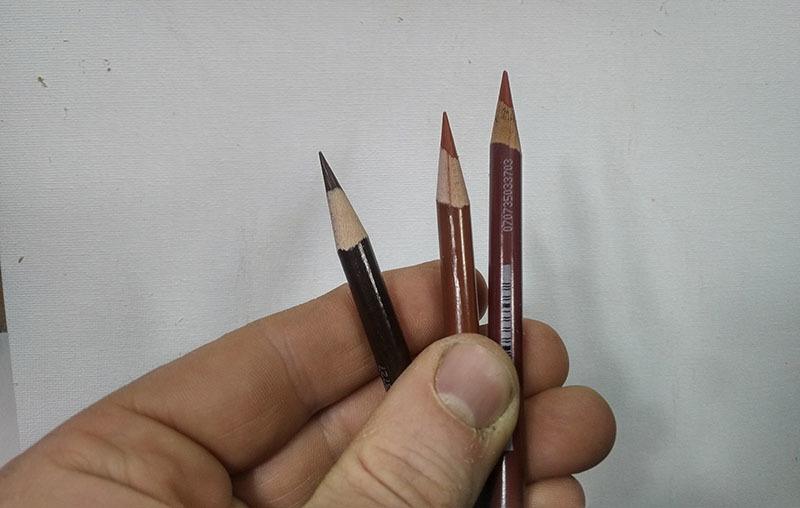
Using colored pencil for your acrylic portrait sketch makes things a lot easier. Technique discovered and developed by Matt Philleo.
4. Do you do the painting from start to finish in one setting?
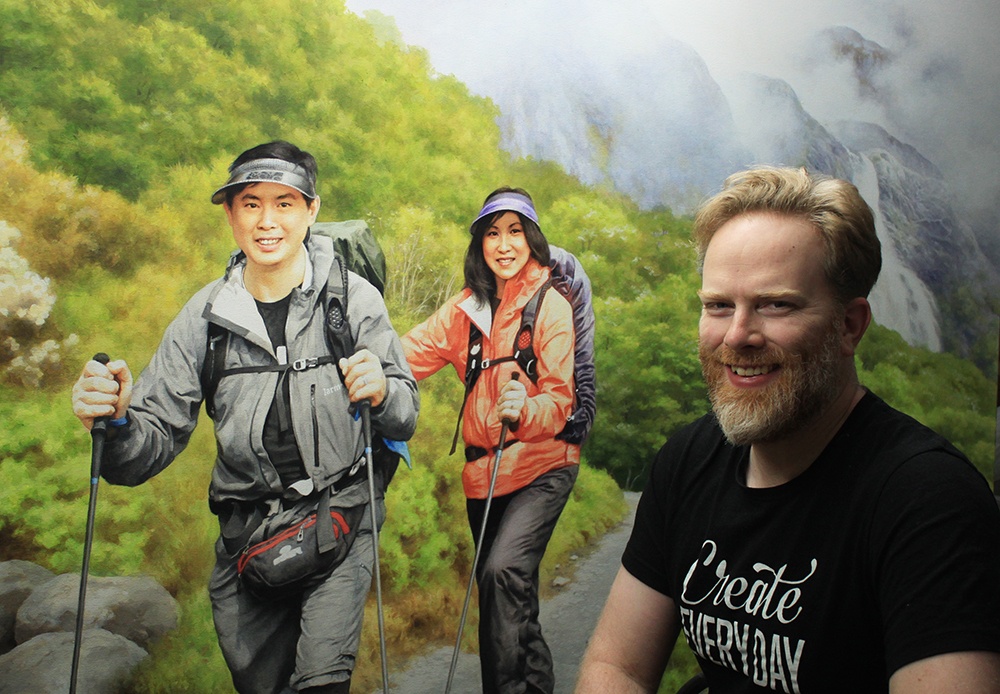
Acrylic portrait artist Matt Philleo posing in front of a 48″ x 72″ commission painting for a client in Brunei
I hope these questions and answers were helpful to you as well. I know some of this stuff seems pretty basic, but it’s good for all of us to pause and think about why we do what we do. It then makes the doing that much more significant.
Let me know if you have any questions of your own about acrylic portrait painting and I’ll do my best to help!

P.S. Did you find this post helpful or encouraging? If so, send it on ahead! Let others know with the share buttons below. I’d love to hear your comments. Thank you so much! Also, do you have a question on acrylic portrait painting you’d like answered? Let me know, and I’d be happy to help!
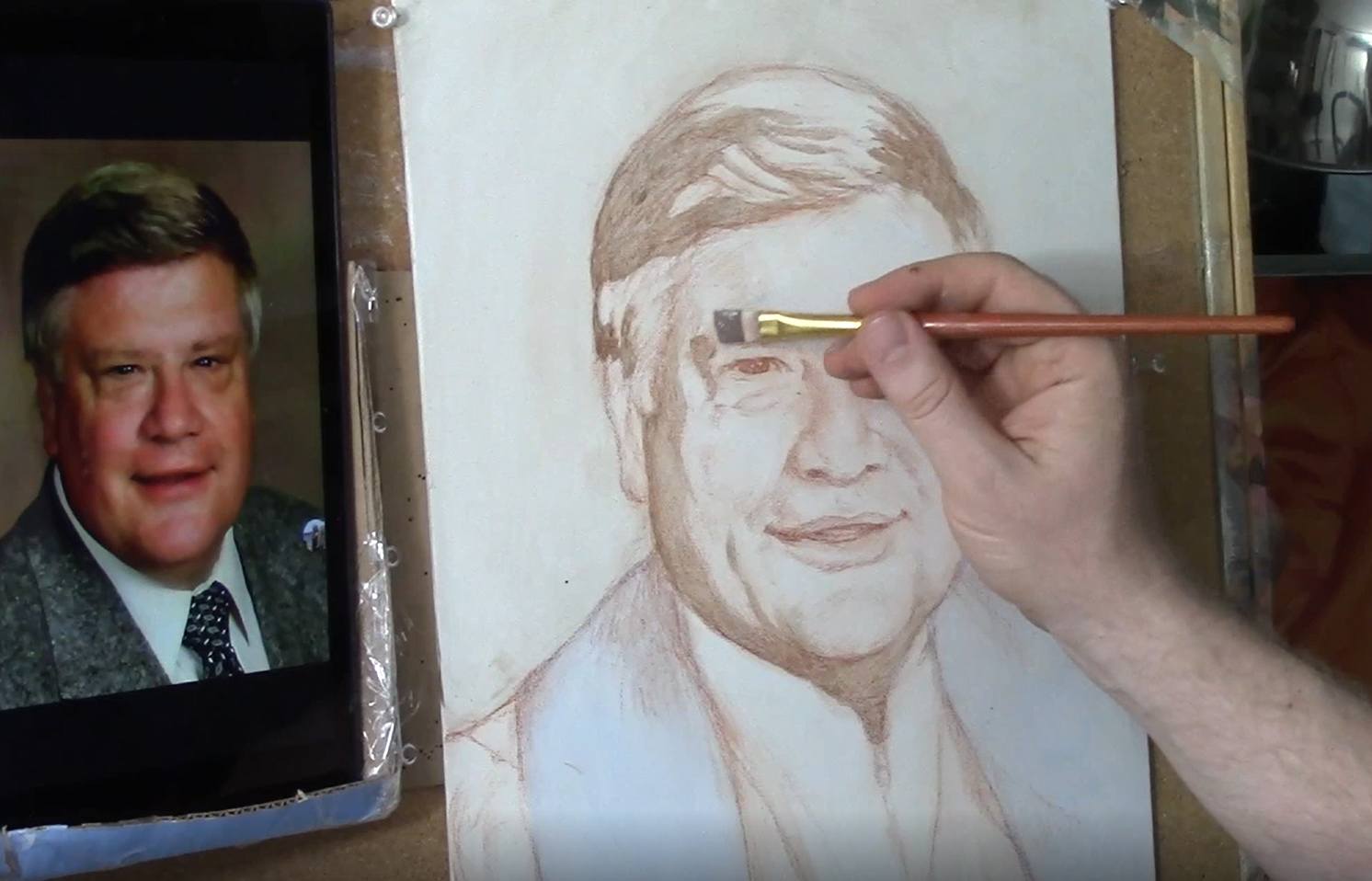
Step-by-Step Process of a Memoriam Portrait (Video Lesson)
Sometimes as portrait artists, we are called to capture the memory of a lost loved one. It’s a very special thing, a privilege that we given, to be able to do that for someone.
I don’t take it lightly.
Recently, I just finished up a commissioned portrait for a friend, whose pastor has recently passed away. This is an 11″ x 14″ acrylic on canvas. I want to show you the entire process, but I’m going to start in this post with just the sketch and first couple layers. Then, we’ll just add on with more steps to this same post.
Many of my blog readers prefer more video content rather than written, so that’s how I’m going to do it here.
Step 1: Blocking in the First Shadows and Tones
Step 2: Filling in the Initial Skin Tone Glaze
Step 3: Integrating the Background and Hair Color
Step 4: How to Paint the Hair
Step 5: How to Paint Nuances in the Skin Tones
Would you like to know when I post another video lesson on this portrait? Click the button below to get my art tips and keep learning!
Learn How to Paint Acrylic Portraits With My Free Mini-Video Course!
Hope you enjoyed this acrylic portrait painting tutorial. As always, let me know how I can help you with your portraits or if you have a question. Leave me a comment below!
Be blessed in your painting,

P.S. Did you find this post helpful or encouraging? If so, send it on ahead! Let others know with the share buttons below. I’d love to hear your comments. Thank you so much! Also, do you have a question on acrylic portrait painting you’d like answered? Let me know, and I’d be happy to help!
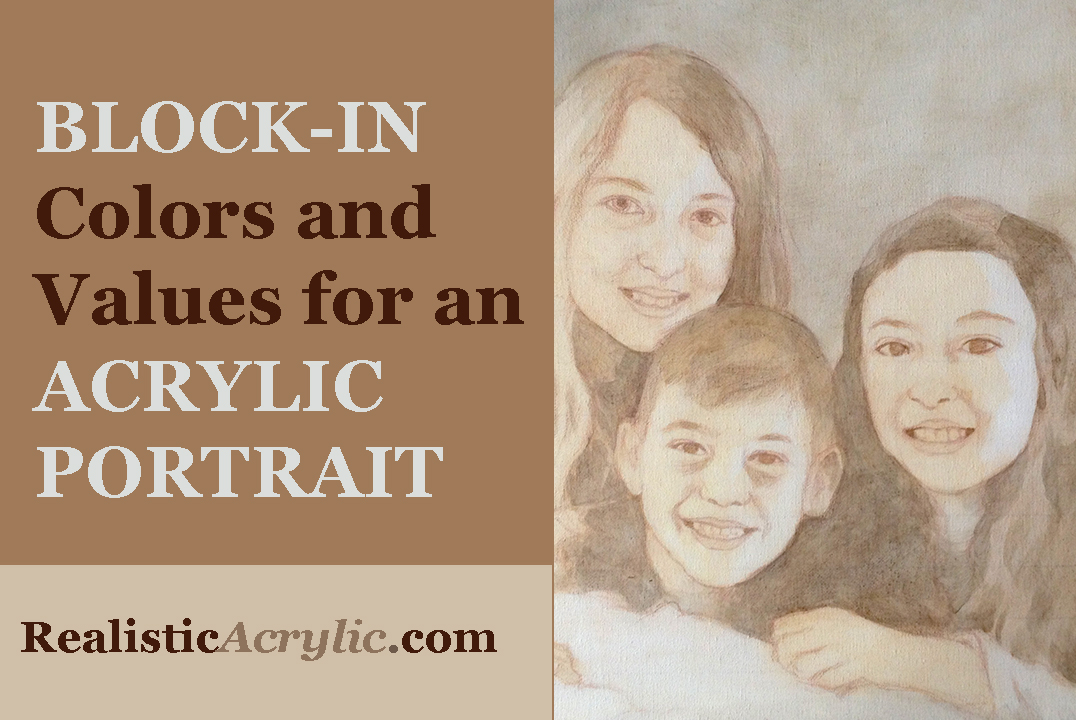
Block in Colors and Values for an Acrylic Portrait
What is the best way to start an acrylic portrait?
Do you just begin with a white canvas, and fully paint everything from left to right, as you would in a drawing?
That’s how I used to paint, until I learned the glazing technique. I would painstakingly render every detail, and move across the surface of the canvas. But I always had a lot of white canvas staring me in the face.
After learning the glazing technique, instead, I could begin to slowly develop the portrait, like an Polaroid photograph.
Psychologically, it felt less intimidating. And it was fun to watch the process of the painting methodically taking shape.
In this video tutorial today, I’m going to show you how I begin my painting–what colors I use, where I put them and why, using this 16″ x 20″ commissioned portrait of three children…
Let me know how this tutorial helps!

P.S. Did you find this post helpful or encouraging? If so, send it on ahead! Let others know with the share buttons below. I’d love to hear your comments. Thank you so much! Also, do you have a question on acrylic portrait painting you’d like answered? Let me know, and I’d be happy to help!
